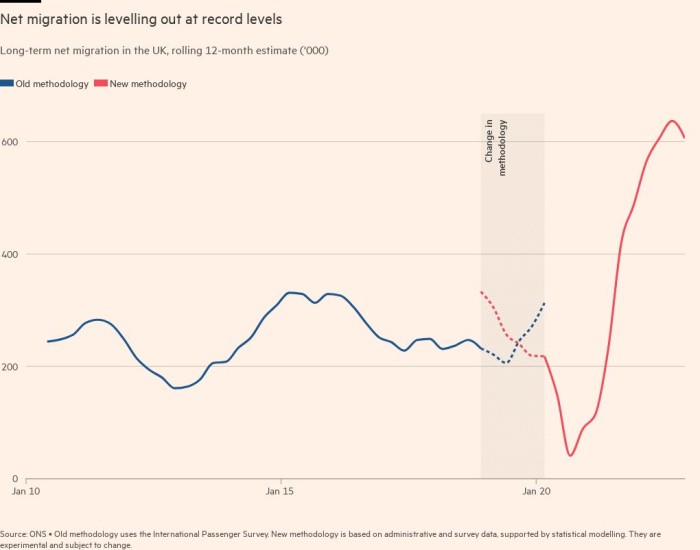[ad_1]
Net migration to the UK rose to an all-time high of 606,000 in 2022, piling pressure on Rishi Sunak’s government, but the country’s statistical agency said the influx was now levelling off.
Thursday’s record figures fell short of some previous predictions that net immigration reached 700,000 last year. However, they contrasted with the Conservatives’ 2019 manifesto pledge — reaffirmed by Sunak — that “overall numbers will come down”.
“Numbers are too high, it’s as simple as that,” the prime minister told ITV after the release of the 606,000 figure. “And I want to bring them down.”
The Office for National Statistics said the total — which compares with a 2021 net immigration figure of 488,000 — was driven by people coming to the UK from outside the EU, including from Ukraine and Hong Kong. But it said that net migration to the UK was now stabilising, with immigration slowing and emigration rising.
The statistics agency also noted that the mix of migrants had changed over the year, with proportionally fewer new arrivals coming as students and more through humanitarian routes.
The ONS estimated gross immigration from outside the EU at about 925,000, up by 287,000 from 2021. Students and their dependants made up more than a third of that total, with 235,000 arriving on work visas and about 250,000 as asylum seekers or through humanitarian routes.
Non-EU emigration also increased, largely due to students returning home, leaving net immigration from outside the EU at 660,000.
Immigration from the EU, which accounted for more than half of arrivals as recently as 2018, totalled just 151,000 in 2022. With 202,000 EU citizens leaving the UK during the year, net EU immigration is now negative.
Jay Lindop, director of the ONS Centre for International Migration, said “unprecedented world events” combined with the lifting of Covid-19 restrictions had led to record immigration levels.
But she added that the evidence suggested immigration had slowed, “potentially demonstrating the temporary nature of these events”.
Immigration remains highly politically charged, with the government under attack from the right, and Labour arguing it has lost control of the issue.
Sunak maintained that measures announced this week to stop overseas students bringing family members with them would bring levels down over time, and urged the public to “rest assured” that he had a grip on the issue.
But current inflows remain far above the government’s 2010 pledge to reduce net immigration to the “tens of thousands”.
The ONS also revised its figure for net immigration for the year ending in June 2022, which now stands at 606,000 after the inclusion of asylum seekers — up from the previous estimate of 504,000.
Tory MPs issued warnings to the government to redouble its efforts to reduce numbers.
“Where on earth are you going to house these people? We build about 180,000 new homes a year,” Conservative former minister Sir John Hayes, who chairs the so-called Common Sense group of rightwing MPs, told the BBC ahead of the figures’ release.
Labour lashed out at the government over the “extraordinary figures”, highlighting that the number of work visas issued had doubled since the start of the coronavirus pandemic.
Yvette Cooper, shadow home secretary, said the government had “no grip on immigration” and had “completely failed to tackle skills shortages, especially in health and social care, or to get people back into work after Covid.”
However, Jonathan Portes, professor at King’s College London, said the figures showed net immigration was likely to fall in 2023.
“The narrative that immigration is spiralling ever upwards or is out of control is simply false,” he said. He added that the figures showed the continued impact of Brexit, with “a complete reorientation of UK migration flows away from the EU and towards the rest of the world”.
Marley Morris, associate director for migration at the think-tank IPPR, said ministers should avoid “knee jerk reactions” to the figures.
He said there were clear signs net immigration was stabilising and there was “strong public support for the main drivers of net migration, including recruitment into the NHS, international students, and humanitarian routes”.
[ad_2]
Source link

